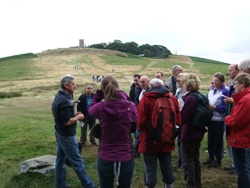Charnia threat
 Roger Mason, discoverer of Charnia masoni, on protecting and publicising Leicestershire’s Ediacaran fossils
Roger Mason, discoverer of Charnia masoni, on protecting and publicising Leicestershire’s Ediacaran fossils
In 1958 Trevor Ford of the Geology Department of Leicester University recorded and published the discovery of Ediacaran fossils in Charnwood. My father had told him of my find of Charnia masoni while they were lecturing at Vaughan College, then the extra-mural department of University College Leicester. By contrast, Tina Negus received wrong information from her school teachers and did not realise the significance of what she had found for almost 50 years.
This has convinced me that geology advances by publicising discoveries rather than keeping them quiet, unless there are reasons not to do so. However, there was an unsuccessful attempt to remove the holotype within weeks of its discovery that initiated a long-standing informal policy of keeping the locations of Precambrian fossils in Charnwood Forest confidential. Quarry workers removed a large block containing the holotype to Leicester New Walk Museum where it is still proudly displayed.
One particularly sensitive site is in Bradgate Park near Leicester (picture) where Ediacaran fossils occur on exposed bedding planes in an Ediacaran to early Cambrian stratigraphical succession that was a venue on the field tour of last year’s Fermor Conference. The Park also has younger stratigraphical, metamorphic, igneous, structural geological and geomorphological features just as good as those of NW Scotland, North Wales and the Lake District. It is a deer park with open public access and generous car parking that surrounds a ruined Tudor mansion, 10 minutes’ drive from the M1 motorway and less than 100 miles from many of England’s universities, colleges and schools. It is owned and managed by Bradgate Park Trust on behalf of the people of Leicester and Leicestershire.
Until recently the Trust’s Land Agent discouraged geological field parties, would not erect geological information signs, and kept fossil localities secret as far as he could. Even so, fossils have been damaged by graffiti on fossiliferous bedding planes and destroyed by attempts at collection, and the problem was getting worse; the most recent graffiti appeared on 6 July this year.
The Charnia Research Group meets at Leicester University and is discussing ways to protect fossils at Charnwood SSSIs with Jonathan Larwood of Natural England. We are particularly concerned about the Bradgate site and agreed in April that protection must be improved. Immediately following this year’s damage, Peter Tyldesley (who has just been appointed Surveyor of Bradgate Park) erected warning signs and a temporary fence round a sensitive bedding plane. There has been no damage since during the summer holidays and visitors asked Park wardens for more information about the site which we hope will soon be provided by permanent signs.
An amateur geologist, Aron Bowers, reported July’s damage, confirming that an informed public should play a major role in protecting Charnwood’s Ediacarans. Bradgate Park is also an ideal site for students to develop independent recording and mapping skills. This truly world-class geological locality should be much more widely publicised. Visit it if you have not yet done so.
Roger Mason